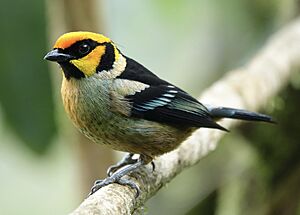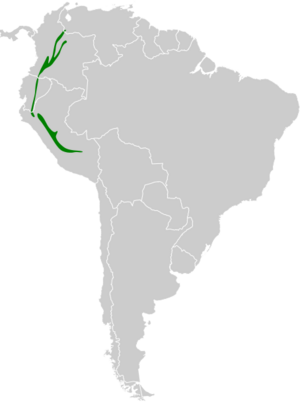Flame-faced tanager facts for kids
Quick facts for kids Flame-faced tanager |
|
|---|---|
 |
|
| T. p. parzudakii | |
 |
|
| T. p. lunigera | |
| Conservation status | |
| Scientific classification | |
 |
|
| Synonyms | |
|
The flame-faced tanager (Tangara parzudakii) is a colorful bird from the tanager family, Thraupidae. These birds are found only in South America. They live in the eastern Andes mountains across Colombia, Ecuador, Peru, and Venezuela.
Their home is in moist, tropical montane forests, which are forests found in mountainous areas. This bird is easy to spot with its black and shiny green upper body. Its underside is also shiny green and buff. The most striking part is its face, which is a mix of deep red and yellow. One type, called lunigera, has an orange-red face instead of deep red.
Flame-faced tanagers eat both plants and animals, making them omnivores. They enjoy fruits and arthropods (like insects and spiders). They often look for food on mossy tree branches. They lay two white eggs with light brown spots during the rainy season. Both parents help feed the young birds, called fledglings.
The International Union for Conservation of Nature (IUCN) lists the flame-faced tanager as a species of "least concern". This means it's not currently in danger of disappearing. However, its numbers are going down because its habitat (its natural home) is being destroyed.
Contents
About the Flame-faced Tanager
The flame-faced tanager was first described in 1843 by Frédéric de Lafresnaye. He named it Tanagra Parzudakii after studying birds from Bogotá, Colombia. The name Tangara comes from a Tupí word meaning "dancer." The second part of its name, parzudakii, honors Charles Parzudaki, a French collector. The official common name for this bird is the flame-faced tanager.
This bird is one of 27 species in the Tangara group. Scientists have used DNA to show that it's related to other colorful tanagers. These include the blue-whiskered tanager and the golden tanager.
Types of Flame-faced Tanagers
There are three main types, or subspecies, of the flame-faced tanager. They look very similar, with only small differences in their feathers.
- T. p. parzudakii: This is the original type. You can find it in southwestern Venezuela, the eastern Colombian Andes, and eastern Ecuador.
- T. p. urubambae: This type lives on the eastern side of the Peruvian Andes. It has a smaller beak and slightly duller colors on its head and belly compared to the first type.
- T. p. lunigera: Sometimes called the yellow-faced tanager, this type is found on the Pacific side of the Colombian Andes and in northwestern Ecuador. It has an orange-red face instead of a deep red one. Some experts even think it might be its own separate species!
What Does a Flame-faced Tanager Look Like?
The flame-faced tanager is a medium-sized bird, about 14 to 15 centimeters (5.5 to 6 inches) long. It weighs around 28 grams (1 ounce). Both male and female birds look alike.
Their bodies are mostly black and a shiny, silvery green. The sides of their head, cheeks, and front of their head are deep red. The top of their head and back of their neck are yellow. Their belly and chest are a mix of shiny green and buff colors. The lower back and rump (the area above the tail) are a shiny golden color, sometimes with a blue tint.
Their eyes are dark brown, their beak is black, and their feet are dark gray. Young flame-faced tanagers have dull yellow on their heads instead of red. Their feathers are generally less bright than adult birds.
The parzudakii type is easy to identify because of its bright red face. The lunigera type, however, might look a bit like the saffron-crowned tanager. But you can tell them apart because the saffron-crowned tanager has a greener chest and is smaller.
Where Do They Live?
Flame-faced tanagers live in the Andes mountains of Colombia, Ecuador, Venezuela, and Peru. They are usually found at heights between 1,000 and 2,600 meters (3,300 to 8,500 feet) above sea level. They prefer cloud forests and other mountain forests. You can also spot them at the edges of forests and in areas where new trees are growing.
How Do They Behave?
You'll often see flame-faced tanagers in pairs or small groups of 3 to 7 birds. They also like to join larger groups of different bird species, especially other tanagers. These mixed groups usually have about seven other bird species in them.
What Do They Eat?
Like other tanagers, the flame-faced tanager eats many different things. They are omnivores, meaning they eat both plants and animals. Their diet includes fruits, arthropods (like insects and spiders), flower buds, and nectar. They mostly look for food high up in the tree canopy.
They especially like fruits from Miconia and Cecropia trees. They often pick fruit directly from branches. They also find arthropods on moss-covered branches, using different ways to catch them.
How Do They Raise Their Young?
In Colombia, people have seen adult birds feeding each other berries in February. This is part of their courtship ritual. In Ecuador, the parzudakii type breeds during the rainy season, from January to July.
Female birds build the nests all by themselves. They choose hidden spots, often in pastures, but also in forests or on man-made structures. The male bird stays nearby but doesn't help build the nest. Nests are like open cups, made from strong fibers, fern pieces, and moss. The inside is lined with soft leaves.
They usually lay two eggs. The female bird sits on the eggs to keep them warm. The male brings her berries while she is incubating. The eggs are white with light brown spots, especially at the wider end. Young birds, or fledglings, have been seen in May. Both parents feed the fledglings. They give them insects like katydids, butterflies and moths, and spiders. They also feed them mashed fruits. The parents also check the nest regularly to remove any parasites. When fledglings are born, they don't have feathers or hair yet.
Is the Flame-faced Tanager in Danger?
The flame-faced tanager is listed as a species of "least concern" by the International Union for Conservation of Nature (IUCN). This is because they have a wide range and are still quite common. However, their population is decreasing. This is mainly due to habitat destruction, which means their natural homes are being lost. The lunigera subspecies, which the IUCN also considers "least concern," faces the same issues.
Images for kids





